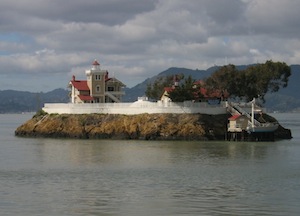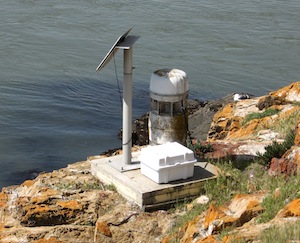Technology and politics are changing the tune of the maritime chorus
Read the full text version of this story at KQED’s QUEST site.

On foggy mornings, I wake up to a faint symphony of foghorns. From my condo on a windy bluff above the Mare Island Strait, the horn on the Carquinez Bridge is the bassoon in the back row, accompanied by the assorted boops and beeps of all the other fog signals within earshot of where the Sacramento River empties into San Pablo Bay.
But the orchestra plays a different tune than it did in decades past. Technology and politics are changing the navigational soundscape of coastal America. Complaints from coastal residents about the repetitive blasts of sound and modern electronic navigation aids have relegated the foghorn to a lesser role in the maritime chorus.
In fact, the iconic “BEEE-ohhh” of the old-fashioned air-powered “diaphone” has virtually disappeared from the score. To my delight, one of the last few diaphones still in working order turns out to be a short drive and five-minute boat ride from my house.
[audio:http://ww2.kqed.org/climatewatch/wp-content/uploads/sites/54/2012/04/EBroDiaphone.mp3|titles=EBroDiaphone]The old diaphone on East Brother Island (officially the Walter Fanning Fog Signal) has been silenced for the purpose of navigation. But Peter Berkhout, who, with his wife Dina, maintains the bed & breakfast in the old lighthouse, has kept the diaphone in superb shape and will crank it up for occasional demonstrations.
Driven by a diesel-power air compressor installed in the 1920s, the horn was originally steam-operated.
“There used to be a big brick hearth with a coal pit and a water tank,” Berkhout explained, “and it would take about 45 minutes to go from cold to having enough steam pressure to blow the horn.”
When the pressure comes up and Berkhout flips the switch, no matter how well you prepare yourself, it’s impossible not to jump just about out of your shoes when the diaphone goes off (you can hear a couple of blasts in my radio story). The sound bounces off the nearby Richmond bluffs and echoes back to the island, washing over you a second time. “I guess you can learn to sleep through anything but I’m glad I haven’t had to learn to sleep through this.”

East Brother Island still has a foghorn, but let’s face it: technology has drained most of the romance out of it. The modern descendent of the Fanning diaphone is a pillar barely bigger than a fire plug, and compared to its predecessor, practically whispers its warning. It’s powered by a solar panel attached to a 12-volt battery. The guys on the Aids to Navigation team at the Coast Guard station on Yerba Buena Island in San Francisco Bay tell me the biggest maintenance challenge is people stealing the batteries.
What sets off a foghorn?
In the old days, fog signals were manned 24-7. When the visibility dropped to a certain point, they’d start up the horns, each of which still has a particular timing signature. Harbor pilot Greg Waugh can still recite them, even though he retired in 2007.
“Center span of the Golden Gate Bridge is two blasts every 40 seconds,” he recalls. “South tower is one blast every 20 seconds. Lime Point on the north tower is one blast every 30 seconds.” He can go on. These signatures allow any sailor with a stopwatch to figure out where he or she is.
Today some horns, such as East Brother’s operate continuously during certain seasons. Others are activated by electric eyes that measure the density of the water vapor in the air. And Waugh says a new system under development will allow ship masters & pilots to activate local signals with their radios.
Waugh says a few years ago, he and his fellow pilots estimated that each year brings about 1,500 hours of fog to the Gate. If you’re doing the math, that means the fog is in almost 20% of the time. Waugh says that while modern aids like GPS and the AIS network for commercial shipping are great, fog-enshrouded mariners can use all the help they can get. “Navigating the fog is like driving down the highway with your hood up,” he says.

